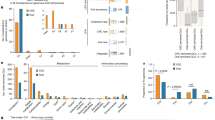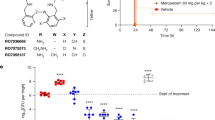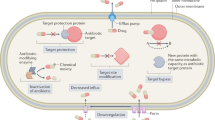Abstract
Vancomycin-resistant Enterococcus faecalis (VREfs) is an important nosocomial pathogen1,2. We undertook whole genome sequencing of E. faecalis associated with bloodstream infection in the UK and Ireland over more than a decade to determine the population structure and genetic associations with hospital adaptation. Three lineages predominated in the population, two of which (L1 and L2) were nationally distributed, and one (L3) geographically restricted. Genome comparison with a global collection identified that L1 and L3 were also present in the USA, but were genetically distinct. Over 90% of VREfs belonged to L1–L3, with resistance acquired and lost multiple times in L1 and L2, but only once followed by clonal expansion in L3. Putative virulence and antibiotic resistance genes were over-represented in L1, L2 and L3 isolates combined, versus the remainder. Each of the three main lineages contained a mixture of vancomycin-resistant and -susceptible E. faecalis (VSEfs), which has important implications for infection control and antibiotic stewardship.
This is a preview of subscription content, access via your institution
Access options
Subscribe to this journal
Receive 12 digital issues and online access to articles
$119.00 per year
only $9.92 per issue
Buy this article
- Purchase on Springer Link
- Instant access to full article PDF
Prices may be subject to local taxes which are calculated during checkout




Similar content being viewed by others
References
Sievert, D. M. et al. Antimicrobial-resistant pathogens associated with healthcare-associated infections: summary of data reported to the National Healthcare Safety Network at the Centers for Disease Control and Prevention, 2009–2010. Infect. Control Hosp. Epidemiol. 34, 1–14 (2013).
Suetens, C., Hopkins, S., Kolman, J. & Diaz Högberg, L. Point prevalence survey of healthcare-associated infections and antimicrobial use in the European acute care hospitals (ECDC, 2013).
Uttley, A. H. C., Collins, C. H., Naidoo, J. & George, R. C. Vancomycin-resistant Enterococci. Lancet 2, 57–58 (1988).
Ruiz-Garbajosa, P. et al. Multilocus sequence typing scheme for Enterococcus faecalis reveals hospital-adapted genetic complexes in a background of high rates of recombination. J. Clin. Microbiol. 44, 2220–2228 (2006).
Freitas, A. R., Novais, C., Ruiz-Garbajosa, P., Coque, T. M. & Peixe, L. Clonal expansion within clonal complex 2 and spread of vancomycin-resistant plasmids among different genetic lineages of Enterococcus faecalis from Portugal. J. Antimicrob. Chemother. 63, 1104–1111 (2009).
Kuch, A. et al. Insight into antimicrobial susceptibility and population structure of contemporary human Enterococcus faecalis isolates from Europe. J. Antimicrob. Chemother. 67, 551–558 (2012).
Kawalec, M. et al. Clonal structure of Enterococcus faecalis isolated from Polish hospitals: characterization of epidemic clones. J. Clin. Microbiol. 45, 147–153 (2007).
Paulsen, I. T. et al. Role of mobile DNA in the evolution of vancomycin-resistant Enterococcus faecalis. Science 299, 2071–2074 (2003).
Palmer, K. L. et al. Comparative genomics of enterococci: variation in Enterococcus faecalis, clade structure in E. faecium, and defining characteristics of E. gallinarum and E. casseliflavus. MBio 3, 1–11 (2012).
Kim, E. B. & Marco, M. L. Nonclinical and clinical Enterococcus faecium strains, but not Enterococcus faecalis strains, have distinct structural and functional genomic features. Appl. Environ. Microbiol. 80, 154–165 (2014).
Hsu, L.-Y. et al. Evolutionary dynamics of methicillin-resistant Staphylococcus aureus within a healthcare system. Genome Biol. 16, 81 (2015).
Donker, T., Wallinga, J., Slack, R. & Grundmann, H. Hospital networks and the dispersal of hospital-acquired pathogens by patient transfer. PLoS ONE 7, e35002 (2012).
Coque, T. M., Tomayko, J. F., Ricke, S. C., Okhyusen, P. C. & Murray, B. E. Vancomycin-resistant enterococci from nosocomial, community, and animal sources in the United States. Antimicrob. Agents Chemother. 40, 2605–2609 (1996).
Jordens, J. Z., Bates, J. & Griffiths, D. T. Faecal carriage and nosocomial spread of vancomycin-resistant Enterococcus faecium. J. Antimicrob. Chemother. 34, 515–528 (1994).
Drummond, A. J., Suchard, M. A., Xie, D. & Rambaut, A. Bayesian phylogenetics with BEAUti and the BEAST 1.7. Mol. Biol. Evol. 29, 1969–1973 (2012).
Palmer, K. L. et al. Enterococcal genomics, in Enterococci: From Commensals to Leading Causes of Drug Resistant Infection (eds Gilmore, M. S. et al.) (Massachusetts Eye and Ear Infirmary, 2014); http://www.ncbi.nlm.nih.gov/books/NBK190425/
Köser, C. U. et al. Rapid whole-genome sequencing for investigation of a neonatal MRSA outbreak. N. Engl. J. Med. 366, 2267–2275 (2013).
Harris, S. R. et al. Evolution of MRSA during hospital transmission and intercontinental spread. Science 327, 469–474 (2010).
Walker, T. M. et al. Whole-genome sequencing to delineate Mycobacterium tuberculosis outbreaks: a retrospective observational study. Lancet Infect. Dis. 13, 137–146 (2013).
Page, A. J. et al. Roary: rapid large-scale prokaryote pan genome analysis. Bioinformatics 31, 3691–3693 (2015).
The Human Microbiome Jumpstart Reference Strains Consortium. A catalog of reference genomes from the human microbiome. Science 328, 994–999 (2010).
Brinster, S., Furlan, S. & Serror, P. C-terminal WxL domain mediates cell wall binding in Enterococcus faecalis and other gram-positive bacteria. J. Bacteriol. 189, 1244–1253 (2007).
Croucher, N. J. et al. Rapid phylogenetic analysis of large samples of recombinant bacterial whole genome sequences using Gubbins. Nucleic Acids Res. 43, e15 (2014).
Marttinen, P. et al. Detection of recombination events in bacterial genomes from large population samples. Nucleic Acids Res. 40, e6 (2012).
Foucault, M., Depardieu, F., Courvalin, P. & Grillot-Courvalin, C. Inducible expression eliminates the fitness cost of vancomycin resistance in enterococci. Proc. Natl Acad. Sci. USA 107, 16964–16969 (2010).
Andrews, J. M. Determination of minimum inhibitory concentrations. J. Antimicrob. Chemother. 48, 5–16 (2001).
Zhou, Y., Liang, Y., Lynch, K. H., Dennis, J. J. & Wishart, D. S. PHAST: a fast phage search tool. Nucleic Acids Res. 39, W347–W352 (2011).
Abbott, J. C., Aanensen, D. M., Rutherford, K., Butcher, S. & Spratt, B. G. WebACT—an online companion for the Artemis Comparison Tool. Bioinformatics 21, 3665–3666 (2005).
Altschul, S. F., Gish, W., Miller, W., Myers, E. W. & Lipman, D. J. Basic local alignment search tool. J. Mol. Biol. 215, 403–410 (1990).
Stamatakis, A. RAxML-VI-HPC: maximum likelihood-based phylogenetic analyses with thousands of taxa and mixed models. Bioinformatics 22, 2688–2690 (2006).
Letunic, I. & Bork, P. Interactive Tree Of Life (iTOL): an online tool for phylogenetic tree display and annotation. Bioinformatics 23, 127–128 (2007).
Jolley, K. A. & Maiden, M. C. J. BIGSdb: scalable analysis of bacterial genome variation at the population level. BMC Bioinformatics 11, 595 (2010).
Baele, G. et al. Improving the accuracy of demographic and molecular clock model comparison while accommodating phylogenetic uncertainty. Mol. Biol. Evol. 29, 2157–2167 (2012).
Baele, G., Li, W. L. S., Drummond, A. J., Suchard, M. A. & Lemey, P. Accurate model selection of relaxed molecular clocks in Bayesian phylogenetics. Mol. Biol. Evol. 30, 239–243 (2013).
Depardieu, F., Perichon, B. & Courvalin, P. Detection of the van alphabet and identification of enterococci and staphylococci at the species level by multiplex PCR. J. Clin. Microbiol. 42, 5857–5860 (2004).
Nallapareddy, S. R., Singh, K. V., Duh, R.-W., Weinstock, G. M. & Murray, B. E. Diversity of ace, a gene encoding a microbial surface component recognizing adhesive matrix molecules, from different strains of Enterococcus faecalis and evidence for production of ace during human infections. Infect. Immun. 68, 5210–5217 (2000).
Shankar, V., Baghdayan, A. S., Huycke, M. M., Lindahl, G. & Gilmore, M. S. Infection-derived Enterococcus faecalis strains are enriched in esp, a gene encoding a novel surface protein. Infect. Immun. 67, 193–200 (1999).
Eaton, T. J. & Gasson, M. J. Molecular screening of Enterococcus virulence determinants and potential for genetic exchange between food and medical isolates. Appl. Environ. Microbiol. 67, 1628–1635 (2001).
Vankerckhoven, V. et al. Development of a multiplex PCR for the detection of asa1, gelE, cylA, esp, and hyl genes in enterococci and survey for virulence determinants among European hospital isolates of Enterococcus faecium. J. Clin. Microbiol. 42, 4473–4479 (2004).
Jurkovic, D. et al. Identification and characterization of enterococci from bryndza cheese. Lett. Appl. Microbiol. 42, 553–559 (2006).
Brinster, S. et al. Enterococcal leucine-rich repeat-containing protein involved in virulence and host inflammatory response. Infect. Immun. 75, 4463–4471 (2007).
Nallapareddy, S. R., Wenxiang, H., Weinstock, G. M. & Murray, B. E. Molecular characterization of a widespread, pathogenic, and antibiotic resistance-receptive Enterococcus faecalis lineage and dissemination of its putative pathogenicity island. J. Bacteriol. 187, 5709–5718 (2005).
La Carbona, S. et al. Comparative study of the physiological roles of three peroxidases (NADH peroxidase, alkyl hydroperoxide reductase and thiol peroxidase) in oxidative stress response, survival inside macrophages and virulence of Enterococcus faecalis. Mol. Microbiol. 66, 1148–1163 (2007).
Theilacker, C. et al. Glycolipids are involved in biofilm accumulation and prolonged bacteraemia in Enterococcus faecalis. Mol. Microbiol. 71, 1055–1069 (2009).
Kemp, K. D., Singh, K. V., Nallapareddy, S. R. & Murray, B. E. Relative contributions of Enterococcus faecalis OG1RF sortase-encoding genes, srtA and bps (srtC), to biofilm formation and a murine model of urinary tract infection. Infect. Immun. 75, 5399–5404 (2007).
Le Jeune, A. et al. The extracytoplasmic function sigma factor SigV plays a key role in the original model of lysozyme resistance and virulence of Enterococcus faecalis. PLoS ONE 5, e9658 (2010).
Teng, F., Singh, K. V., Bourgogne, A., Zeng, J. & Murray, B. E. Further characterization of the epa gene cluster and Epa polysaccharides of Enterococcus faecalis. Infect. Immun. 77, 3759–3767 (2009).
Coburn, P. S., Baghdayan, A. S., Dolan, G. T. & Shankar, N. An AraC-type transcriptional regulator encoded on the Enterococcus faecalis pathogenicity island contributes to pathogenesis and intracellular macrophage survival. Infect. Immun. 76, 5668–5676 (2008).
Dutka-Malen, S., Evers, S. & Courvalin, P. Detection of glycopeptide resistance genotypes and identification to the species level of clinically relevant enterococci by PCR. J. Clin. Microbiol. 33, 1434 (1995).
Zankari, E. et al. Identification of acquired antimicrobial resistance genes. J. Antimicrob. Chemother. 67, 2640–2644 (2012).
Cattoir, V., Huynh, T. M., Bourdon, N., Auzou, M. & Leclercq, R. Trimethoprim resistance genes in vancomycin-resistant Enterococcus faecium clinical isolates from France. Int. J. Antimicrob. Agents 34, 390–392 (2009).
Braga, T. M., Marujo, P. E., Pomba, C. & Lopes, M. F. S. Involvement, and dissemination, of the enterococcal small multidrug resistance transporter QacZ in resistance to quaternary ammonium compounds. J. Antimicrob. Chemother. 66, 283–286 (2011).
Kado, C. I. & Liu, S.-T. Rapid procedure for detection and isolation of large and small plasmids. J. Bacteriol. 145, 1365–1373 (1981).
Acknowledgements
The authors thank the Wellcome Trust Sanger Institute library construction, sequence and core informatics teams, the staff at BSAC and the Cambridge Public Health England Microbiology and Public Health Laboratory, and H. Brodrick, A. Cain, D. Pickard, K. Judge and E. Blane for their technical support. The authors acknowledge BSAC for allowing the use of isolates from the BSAC Resistance Surveillance Project. This publication presents independent research supported by the Health Innovation Challenge Fund (HICF-T5-342 and WT098600), a parallel funding partnership between the UK Department of Health and the Wellcome Trust. The views expressed in this publication are those of the authors and not necessarily those of the Department of Health or the Wellcome Trust. This project was also funded by a grant awarded to the Wellcome Trust Sanger Institute (098051). M.E.T. is a Clinical Scientist Fellow supported by the Academy of Medical Sciences, the Health Foundation and the NIHR Cambridge Biomedical Research Centre.
Author information
Authors and Affiliations
Contributions
S.J.P. designed the study. K.E.R. performed bacterial identification, susceptibility testing and DNA extraction, and analysed the data. S.R. assisted with bioinformatic analysis. T.G., R.R., J.E.R., N.M.B. and J.P. contributed materials and data. M.E.T. completed ethical approvals. J.P. and S.J.P. were responsible for supervision and management of the study.
Corresponding author
Ethics declarations
Competing interests
The authors declare no competing financial interests.
Supplementary information
Supplementary Information
Supplementary Figures 1–5 and Tables 2–4. (PDF 1429 kb)
Supplementary Table 1
Isolate details. (XLSX 5080 kb)
Rights and permissions
About this article
Cite this article
Raven, K., Reuter, S., Gouliouris, T. et al. Genome-based characterization of hospital-adapted Enterococcus faecalis lineages. Nat Microbiol 1, 15033 (2016). https://doi.org/10.1038/nmicrobiol.2015.33
Received:
Accepted:
Published:
DOI: https://doi.org/10.1038/nmicrobiol.2015.33
This article is cited by
-
Circular and L50-like leaderless enterocins share a common ABC-transporter immunity gene
BMC Genomics (2023)
-
VanA-Enterococcus faecalis in Poland: hospital population clonal structure and vanA mobilome
European Journal of Clinical Microbiology & Infectious Diseases (2022)
-
Apparent nosocomial adaptation of Enterococcus faecalis predates the modern hospital era
Nature Communications (2021)
-
Stunted microbiota and opportunistic pathogen colonization in caesarean-section birth
Nature (2019)
-
Comparative genomic analysis of Enterococcus faecalis: insights into their environmental adaptations
BMC Genomics (2018)



